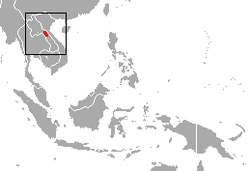| Laotian langur [1] | |
|---|---|
 | |
| Scientific classification | |
| Kingdom: | Animalia |
| Phylum: | Chordata |
| Class: | Mammalia |
| Order: | Primates |
| Suborder: | Haplorhini |
| Infraorder: | Simiiformes |
| Family: | Cercopithecidae |
| Genus: | Trachypithecus |
| Species group: | Trachypithecus francoisi group |
| Species: | T. laotum |
| Binomial name | |
| Trachypithecus laotum (Thomas, 1921) | |
 | |
| Laotian langur range | |
The Laotian langur or white-browed black langur (Trachypithecus laotum) is a species of the primate family Cercopithecidae that is endemic to Laos in Southeast Asia. It is closely related to other primates found in the region such as Indochinese black langur and Hatinh langur. It is classified as endangered in the IUCN Red List.
